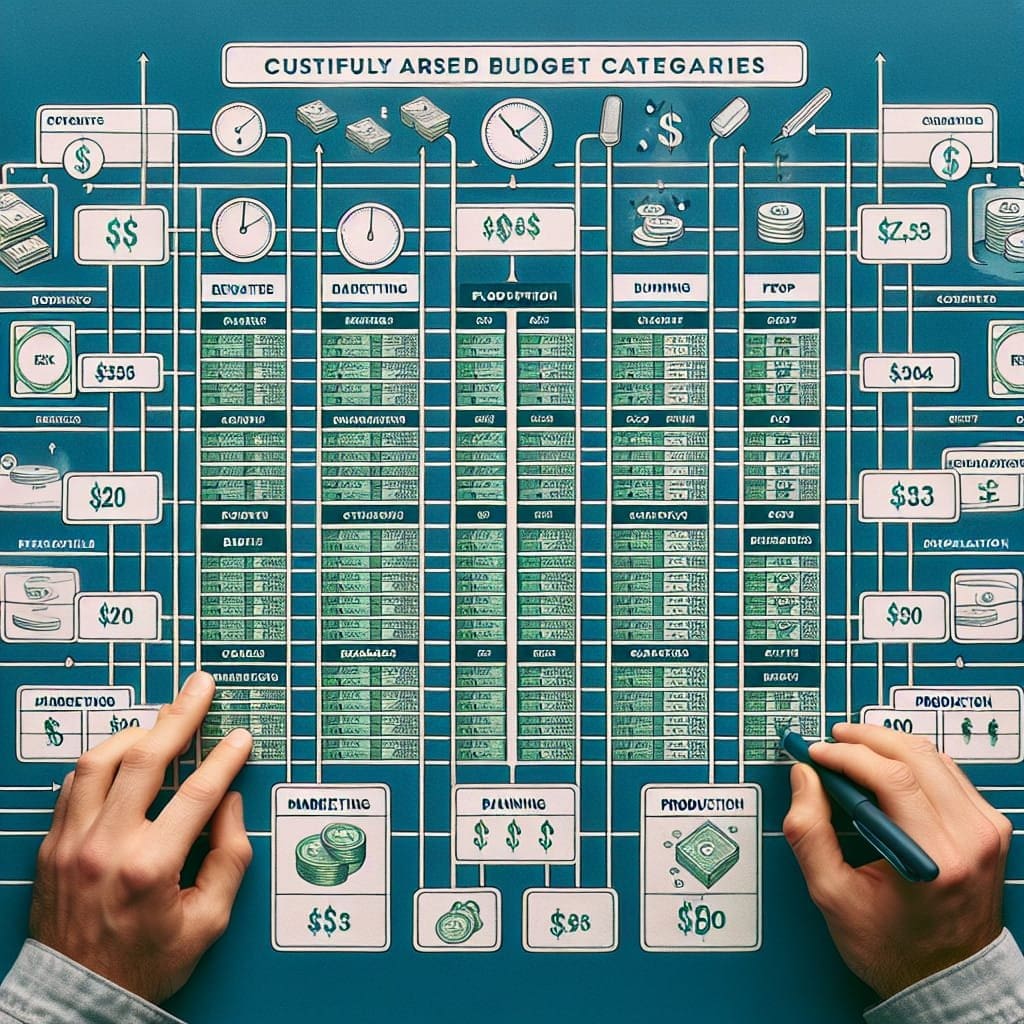Are you thinking of launching a Kickstarter campaign? If so, it's important to have a comprehensive budget in place to ensure your project's success. This article will guide you through the essential steps of creating a Kickstarter campaign budget, providing you with tips and strategies to make the most out of your funding goals. From outlining the necessary expenses to calculating potential rewards and shipping costs, we've got you covered. So, grab a pen and paper, and let's dive into the world of Kickstarter budgeting together!

Determining Financial Goals
Setting clear financial goals is crucial when creating a Kickstarter campaign budget. This will help you determine the funding target you need to reach and plan for any additional stretch goals you might have. By having a clear understanding of your financial goals, you will be able to better allocate your resources and gauge the success of your campaign.
Project Scope
Before you can determine your financial goals, it is important to define the scope of your project. This includes outlining the specific features, functionalities, and objectives of your product or idea. By clearly defining your project scope, you can identify the necessary expenses and resources required to bring it to life.
Funding Target
The funding target is the amount of money you aim to raise through your Kickstarter campaign. It should be based on a realistic assessment of the costs involved in the entire project, including production, manufacturing, marketing, and any other associated expenses. It is important to carefully calculate your funding target to ensure you have enough funds to fulfill your promises to backers and complete your project successfully.
Stretch Goals
Stretch goals are additional funding targets that go beyond your initial funding goal. These goals are set to incentivize backers and attract more support by offering additional features, variations, or enhancements to the product or project. While stretch goals can be exciting and help drive more funding, it is essential to carefully consider the costs and feasibility of each stretch goal before incorporating them into your budget.
Pre-Campaign Expenses
Even before launching your Kickstarter campaign, there are several expenses you need to consider.
Market Research
Market research is a crucial step in understanding your target audience, identifying competitors, and assessing the demand for your product or idea. Allocating funds towards market research will help you make informed decisions in terms of pricing, positioning, and marketing strategies.
Prototype Development
Prototyping is essential to demonstrate the functionality and design of your product. The costs associated with prototyping may include materials, manufacturing or assembly fees, and any necessary modifications based on feedback and testing.
Design and Marketing Assets
Creating visually appealing design and marketing assets is vital for attracting backers and effectively communicating your product or idea. This may include graphic design, photography, video production, and web development costs. These expenses should be carefully considered to ensure they align with your overall budget.
/gvGjkPAXRlQ” frameborder=”0″ allowfullscreen>
Campaign Costs
Once your Kickstarter campaign is live, there are various costs directly related to the campaign itself.
Platform Fees
Kickstarter charges a fee for using their platform, typically a percentage of the funds raised. Familiarize yourself with these fees and factor them into your budget when calculating your funding target.
Reward Costs
Rewards are an integral part of Kickstarter campaigns, and they can range from simple thank-you notes to exclusive merchandise or early access to the product. Consider the costs of producing and delivering these rewards, including manufacturing, packaging, and shipping expenses.
Shipping and Fulfillment
Shipping and fulfillment costs can vary significantly depending on the size and weight of your product, as well as the shipping destinations. Carefully assess the potential costs of shipping and fulfillment to avoid any surprises and ensure a smooth delivery process.
Marketing and Advertising
In order to generate awareness and attract backers to your Kickstarter campaign, you will need to invest in effective marketing and advertising strategies.
Social Media Advertising
Utilizing social media platforms such as Facebook, Instagram, and Twitter is an effective way to reach your target audience. Allocate a portion of your budget towards social media advertising to maximize visibility and engagement.
Influencer Collaborations
Partnering with influencers or industry experts can significantly boost the credibility and visibility of your campaign. Consider the costs associated with influencer collaborations, such as sponsored content or product endorsements, and incorporate them into your marketing budget.
Public Relations
Public relations efforts can help generate media coverage and increase the exposure of your Kickstarter campaign. Consider allocating funds for press releases, media kits, and outreach to relevant journalists and bloggers to amplify your campaign's message.

Operations and Team Expenses
Running a successful Kickstarter campaign requires adequate resources and a dedicated team.
Staffing
If you require additional team members to manage various aspects of your campaign, it is important to consider the costs associated with wages, salaries, or freelancers. This includes roles such as project managers, customer service representatives, and marketing specialists.
Office Space
If you require a physical location for your team to work together, allocate funds for rent, utilities, and any necessary office supplies or equipment. Alternatively, if remote work is a viable option, consider the costs associated with remote collaboration software and communication tools.
Equipment and Software
Investing in quality equipment and software is essential for smooth operations and efficient execution of your Kickstarter campaign. This may include computers, cameras, project management tools, design software, and other necessary equipment specific to your project's requirements.
Professional Services
There are various professional services that can contribute to the success of your Kickstarter campaign.
Legal Fees
Consulting with legal professionals can ensure that your campaign and product comply with the applicable laws and regulations. Allocate funds for legal advice, trademark registrations, and any other legal expenses that may arise.
Accounting and Bookkeeping
Properly managing your finances is crucial for running a successful and transparent Kickstarter campaign. Consider hiring an accountant or bookkeeper to handle financial tracking, reporting, and tax obligations.
Consultation Services
You may require expert guidance or consultation in areas such as crowdfunding strategies, manufacturing processes, or product development. Allocate funds for consulting services to ensure you have access to industry expertise throughout your campaign.
Contingency Fund
Despite careful planning, unexpected expenses and challenges may arise during your Kickstarter campaign. Set aside a contingency fund to account for these unforeseen circumstances and ensure that you have enough resources to overcome any obstacles.
Unforeseen Expenses
Unanticipated costs, such as additional manufacturing or production fees, marketing opportunities, or unexpected legal matters, can arise throughout the campaign. Having a contingency fund will provide you with the flexibility to address these unforeseen expenses without compromising the success of your project.
Production Delays
Delays in production can occur due to various factors, including material shortages, equipment malfunctions, or unforeseen technical challenges. Allocating funds to manage any potential delays will help you fulfill your promises to your backers within a reasonable timeframe.
Shipping and Customs Issues
Shipping and customs can sometimes present unexpected challenges, particularly when delivering internationally. Customs fees, import taxes, or unexpected shipping delays can impact your budget. Having a contingency fund will help alleviate any financial strain caused by these issues.
Stretch Goals Allocation
If you successfully meet your initial funding target, it is important to plan how to allocate any additional funds raised towards stretch goals.
Additional Features
Consider enhancing your product or project by adding new features, improving existing functionalities, or incorporating innovative technologies. Allocate funds to cover the costs associated with research, development, and implementation of these additional features.
New Product Variations
Expanding your product line by offering different variations can cater to a broader audience and generate more interest. Allocating funds towards researching, designing, and producing new product variations will allow you to offer more options to your backers.
Enhanced Manufacturing
With additional funds from stretch goals, you can invest in better manufacturing processes, materials, or equipment. This can lead to improvements in product quality, efficiency, and scalability, resulting in a better end product for your backers.
After-Campaign Expenses
Once your Kickstarter campaign ends, there are several expenses to consider in the post-campaign phase.
Production and Manufacturing
Allocate funds for the production and manufacturing of your product. This includes manufacturing costs, raw materials, quality control, and any necessary modifications or adjustments based on feedback received during the campaign.
Quality Assurance
Ensure that your product meets the highest quality standards by allocating funds for thorough quality assurance processes. This may include testing, certifications, and inspections to ensure that your backers receive a reliable and satisfactory product.
Inventory and Warehousing
If you anticipate a high demand for your product, allocate funds for inventory and warehousing expenses. This will ensure that you have enough stock to fulfill orders promptly and efficiently.
Post-Campaign Fulfillment
Successfully delivering your product to your backers is critical for maintaining customer satisfaction and loyalty.
Packaging and Shipping
Allocate funds for packaging materials, such as boxes, labels, and protective padding, as well as shipping expenses required to fulfill backers' orders. Carefully consider the various shipping options and select the most cost-effective and reliable method to ensure timely delivery.
Customer Service
Maintaining good customer service is essential for cultivating a positive brand image and satisfying your backers. Allocate funds for customer service representatives who can promptly respond to inquiries, resolve issues, and provide support throughout the fulfillment process.
Returns and Refunds
Account for potential returns and refunds as part of your post-campaign budget. It's important to have the financial resources to address any issues or dissatisfaction from backers and offer a smooth returns and refunds process, if necessary.
By considering each of these sections in your Kickstarter campaign budget, you can create a comprehensive financial plan that covers all the necessary expenses and ensures a smooth and successful campaign from start to finish. Stay organized, track your expenses, and adapt your budget as needed to ensure the best possible outcome for your project. Good luck!






